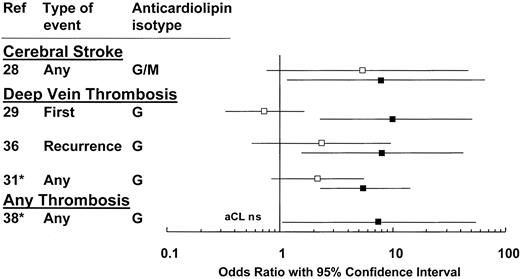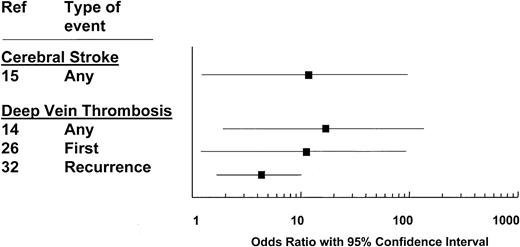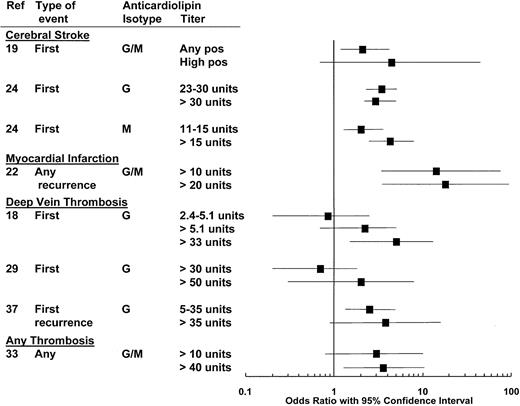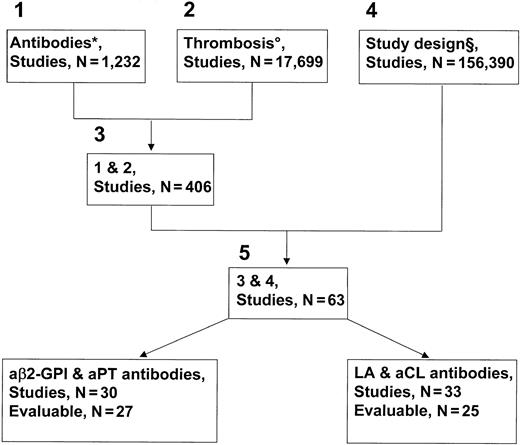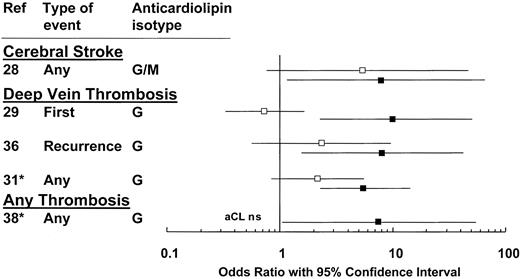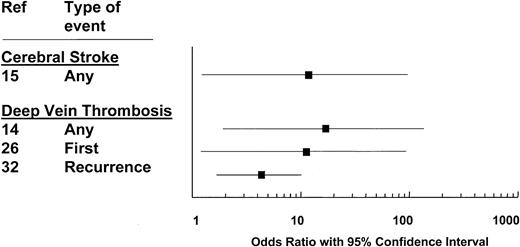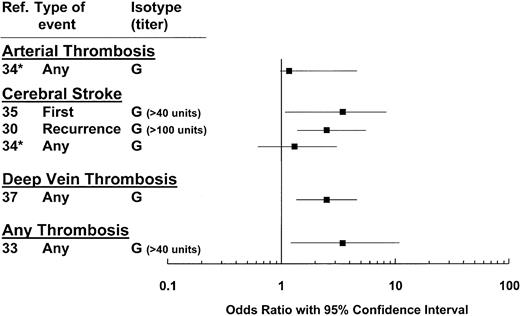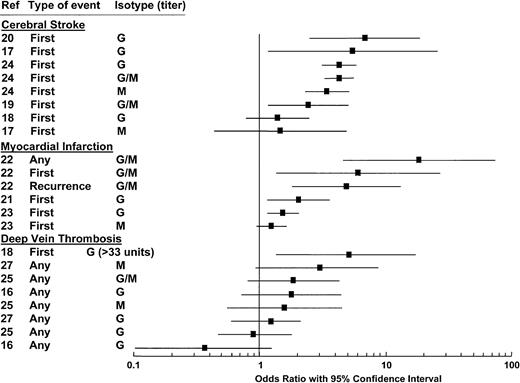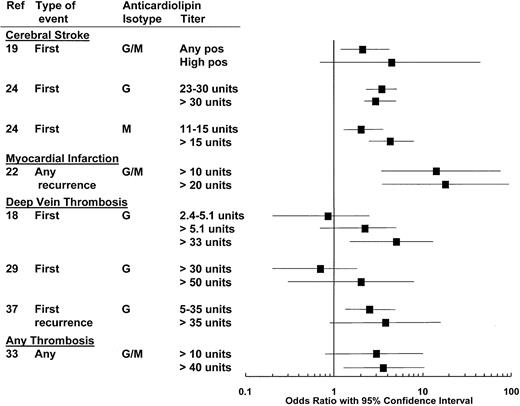To formally establish the risk of lupus anticoagulants and anticardiolipin antibodies for arterial and venous thrombosis, we ran a MEDLINE search of the literature from 1988 to 2000. Studies were selected for their case-control (11), prospective (9), cross-sectional (3), and ambispective (2) design. They provided or enabled us to calculate the odds ratio with 95% confidence interval (CI) of lupus anticoagulants and/or anticardiolipin antibodies for thrombosis in 4184 patients and 3151 controls. Studies were grouped according to the antibody investigated. Five studies compared lupus anticoagulants with anticardiolipin antibodies: the odds ratio with 95% CI of lupus anticoagulants for thrombosis was always significant. None of them found anticardiolipin antibodies were associated with thrombosis. Four studies analyzed only lupus anticoagulants: the odds ratio with 95% CI was always significant. The risk of lupus anticoagulants was independent of the site and type of thrombosis, the presence of systemic lupus erythematosus, and the coagulation tests employed to detect them. Sixteen studies served to assess 28 associations between anticardiolipin antibodies and thrombosis: the odds ratio with 95% CI was significant in 15 cases. Anticardiolipin titer correlated with the odds ratio of thrombosis. In conclusion, the detection of lupus anticoagulants and, possibly, of immunoglobulin G (IgG) anticardiolipin antibodies at medium or high titers helps to identify patients at risk for thrombosis. However, to take full advantage of the conclusions provided by the available evidence, there is an urgent need to harmonize investigational methods.
Introduction
Antiphospholipid antibodies are a heterogeneous family of immunoglobulins that includes, among others, lupus anticoagulants and anticardiolipin antibodies. Lupus anticoagulants behave as acquired inhibitors of coagulation, prolonging phospholipid-dependent in vitro coagulation tests,1 and anticardiolipin antibodies are measured by immunoassay, utilizing cardiolipin or other anionic phospholipids in solid phase.2 Despite their name, antiphospholipid antibodies do not recognize phospholipids, but plasma proteins bound to suitable anionic (not necessarily phospholipid) surfaces. Among these, β2-glycoprotein I3,4 and prothrombin5 are the most widely investigated antigenic targets. Most anticardiolipin antibodies need β2-glycoprotein I to react with cardiolipin in immunoassays.4 Specific subgroups of anti–β2-glycoprotein I6 and antiprothrombin7 antibodies are responsible for the lupus anticoagulant activity in phospholipid-dependent coagulation tests. Clinical interest in antiphospholipid antibodies is due to their relation with arterial and venous thrombosis in the antiphospholipid syndrome. Two forms of antiphospholipid syndrome have been described: a “primary” syndrome,8 with no evidence of an underlying disease, and a “secondary” syndrome, mainly in the setting of systemic lupus erythematosus.9 Thromboembolic events are reported in approximately one third of antiphospholipid-positive patients. Preliminary clinical and laboratory criteria for definite antiphospholipid syndrome have been published.10 The relationship between lupus anticoagulants and anticardiolipin antibodies and thrombosis has been amply investigated. However, the results of clinical studies are largely influenced by factors such as differences in study design and eligibility criteria and by the diversity of antiphospholipid antibodies in terms of types, isotypes, cutoff, and laboratory methods employed for their detection. The strength of the association of lupus anticoagulants and anticardiolipin antibodies with thrombosis thus remains to be established. To contribute to this issue, we made a systematic review of the literature on the antiphospholipid syndrome. We selected papers whose design allowed us to objectively verify the clinical events and to establish the odds ratio with 95% confidence interval (CI) of lupus anticoagulants and anticardiolipin antibodies for thrombosis. Whenever possible, the antibody isotype(s) and titers, the site of thrombosis, and the primary or secondary nature of the antiphospholipid syndrome were taken into account.
Lupus anticoagulants were strong risk factors for both arterial and venous thrombosis. This conclusion cannot be drawn for anticardiolipin antibodies in general, but it applies in specific conditions.
Patients, materials, and methods
Literature search and selection of studies
Articles were identified by a computer-assisted (MEDLINE) search of the literature published in English from 1988 through 2000. A schematic representation of the search strategy is given in Figure1.
Literature search strategy on the association between antiphospholipid antibodies and thrombosis.
Key words were as follows. *Antibodies: antiphospholipid, anticardiolipin, lupus coagulation inhibitor, antiphospholipid syndrome; ° thrombosis: thrombophlebitis, pulmonary embolism, thromboembolism, myocardial infarction, cerebral ischemia, cerebral ischemia transient; § study design: cohort (ie, prospective), cross-sectional, case-control, ambispective, retrospective. aβ2-GPI indicates anti–β2-glycoprotein I; aPT, antiprothrombin; LA, lupus anticoagulants; and aCL, anticardiolipin. Numbers 1 to 5 indicate the sequence followed in the literature strategy.
Literature search strategy on the association between antiphospholipid antibodies and thrombosis.
Key words were as follows. *Antibodies: antiphospholipid, anticardiolipin, lupus coagulation inhibitor, antiphospholipid syndrome; ° thrombosis: thrombophlebitis, pulmonary embolism, thromboembolism, myocardial infarction, cerebral ischemia, cerebral ischemia transient; § study design: cohort (ie, prospective), cross-sectional, case-control, ambispective, retrospective. aβ2-GPI indicates anti–β2-glycoprotein I; aPT, antiprothrombin; LA, lupus anticoagulants; and aCL, anticardiolipin. Numbers 1 to 5 indicate the sequence followed in the literature strategy.
Next, for lupus anticoagulants and anticardiolipin antibodies we focused on studies that met the following requirements besides the objective documentation of thrombosis: specification of the temporal sequence between measurement of the antibodies and the events, or the presence of a control group. Prospective, cross-sectional, case-control, and ambispective studies met these criteria. Ambispective studies combine features of both prospective and retrospective designs. In such studies, either one primary variable is measured prospectively and the other retrospectively, or one primary variable is measured both ways.11 The bibliographies of all articles and reviews retrieved were then scanned for references not identified in the initial search. All series of 10 or more patients were classified according to the antiphospholipid antibody type and the underlying disease, and information about the study design and the assay methods was recorded.
Two independent assessors reviewed each study.
Assessment of validity
The patient population and laboratory methods were systematically examined.
Patient population.
We noted whether eligibility criteria and confounding factors were specified for patients and, when included, controls. Patients were classified according to their underlying disease or syndrome. The major categories included systemic lupus erythematosus, other autoimmune diseases, nonautoimmune diseases, arterial thrombosis, and venous thrombosis.
Assay methods.
Only studies that objectively verified the thromboembolic events were included. The following methods were used: computerized ultrasonography or venography for deep vein thrombosis; radionuclide lung scanning or angiography for pulmonary embolism; arteriography for peripheral arterial occlusions; computed tomography, resonance imaging, or angiography for ischemic stroke; and electrocardiogram and cardiac enzymes for myocardial infarction. Among the details of thrombosis, we noted the site (arterial or venous) and whether it was the first episode or a recurrence. The diagnosis of lupus anticoagulants followed the criteria set by the Subcommittee for the Standardization of Lupus Anticoagulants of the International Society of Thrombosis and Haemostasis.12 The type and number of coagulation tests were recorded. The diagnosis of anticardiolipin antibodies followed the criteria set by several international workshops (reviewed by Pierangeli et al13). We noted the anticardiolipin antibody isotype(s), whether the normal cutoff was used, and how it was expressed (ie, the number of standard deviations above the mean of controls, the multiple of the mean, the tertile, or quartile). Many studies expressed anticardiolipin antibodies in GPL and MPL units, 1 unit being equivalent to 1 μg of immunoglobulin G (IgG) (for GPL) or IgM (for MPL) anticardiolipin antibody purified from 1 mL of serum.13 In view of the current lack of standardization of coagulation tests and immunoassays, the decision to include or exclude a study did not take into account the method used to detect antiphospholipid antibodies.
Statistical analysis
Odds ratios with 95% CI of lupus anticoagulants and anticardiolipin antibodies for arterial and/or venous thrombosis were recorded or, if not available, calculated for each study, whenever possible, by means of contingency tables. In case-control and cross-sectional studies, contingency tables were used to compare the proportion of lupus anticoagulants and/or anticardiolipin antibodies in patients with and without thrombosis. In prospective studies, contingency tables were established as follows: (1) if systemic lupus erythematosus was the enrollment criterion, the odds ratio with 95% CI was calculated by comparing the proportion of lupus anticoagulants and/or anticardiolipin antibodies in patients who did or did not develop thrombosis during follow-up; (2) if thrombosis was the enrollment criterion, the odds ratio with 95% CI was calculated by comparing the proportion of lupus anticoagulants and/or anticardiolipin antibodies in patients with or without recurrent thrombosis during follow-up; and (3) if positivity for lupus anticoagulants and/or anticardiolipin antibodies was the enrollment criterion, the odds ratio with 95% CI was calculated by comparing the rates of thrombosis during follow-up of patients grouped according to different antibody types and titers.
Results
Literature search strategy and articles retrieved
Sixty-three articles were retrieved: 33 investigated lupus anticoagulants and/or anticardiolipin antibodies,14-46 and the other 30 dealt with anti–β2-glycoprotein I and/or antiprothrombin antibodies (Figure 1). The analysis presented here deals only with lupus anticoagulants and anticardiolipin antibodies; studies on anti–β2-glycoprotein I and antiprothrombin antibodies will be reviewed separately. In 8 papers the odds ratio with 95% CI toward thrombosis was not provided and could not be calculated, and these were therefore excluded; they were 4 ambispective39,41-43 and 4 prospective40 44-46 studies on 1266 patients. Their enrollment criteria were systemic lupus erythematosus in 667 cases, presence of lupus anticoagulants and/or anticardiolipin antibodies in 502, and cerebral stroke in the remaining 97 patients. The main characteristics of the remaining 25 articles are reported in Table1.
Eleven case-control, 3 cross-sectional, and 2 ambispective studies gave information on 2208 patients and 3151 controls, and 9 prospective studies contributed another 1976 patients. As shown in Table 1, at least 10 different screening and confirmatory assays were used either alone or in various combinations to detect lupus anticoagulants. Three studies26,32,36 did not provide enough information about the laboratory methods used to diagnose lupus anticoagulants. Three studies32,34 36 did not give laboratory details about anticardiolipin antibody detection.
For analysis, studies were grouped according to the antiphospholipid antibody: those allowing the comparison of lupus anticoagulants and anticardiolipin antibodies for their association with thrombosis, those dealing only with lupus anticoagulants, and those dealing only with anticardiolipin antibodies.
Studies on lupus anticoagulants and anticardiolipin antibodies
Twelve studies measured lupus anticoagulants and anticardiolipin antibodies (Table 1), but only 5 compared them for their odds ratio with 95% confidence interval for thrombosis. They were 2 ambispective28,29 and 3 prospective studies31,36 37 on 753 patients and 234 controls.
Results were grouped according to the type of thrombosis in each study (cerebral stroke, deep vein thrombosis, or any thrombosis, which means that no distinction was possible between arterial and venous forms). Further classification was based on the study design, the type of event (first event, recurrence, or any event, which means that no distinction was possible between first or recurrent event), whether or not patients suffered from systemic lupus erythematosus, and the anticardiolipin isotype.
Irrespective of these parameters, all studies reported a significant 95% CI between lupus anticoagulants and thrombosis, and the odds ratio ranged from 5.71 to 9.4 (Figure 2). In contrast, anticardiolipin antibodies were never significantly associated with arterial or venous thrombosis.
Comparison of lupus anticoagulants (▪) and anticardiolipin antibodies (■) for their association with thrombosis: analysis of 5 studies on 753 patients and 234 controls.
Odds ratios with 95% CI are grouped according to the site and type of thrombosis and the study design.*Studies in systemic lupus erythematosus. ns indicates not significant; and Ref, reference.
Comparison of lupus anticoagulants (▪) and anticardiolipin antibodies (■) for their association with thrombosis: analysis of 5 studies on 753 patients and 234 controls.
Odds ratios with 95% CI are grouped according to the site and type of thrombosis and the study design.*Studies in systemic lupus erythematosus. ns indicates not significant; and Ref, reference.
Studies on lupus anticoagulants
Four studies analyzed only lupus anticoagulants (Figure3). They were 1 prospective,32 1 cross-sectional,26 and 2 case-control studies14 15 on 226 patients and 447 controls. Results were grouped as described in “Studies on lupus anticoagulants and anticardiolipin antibodies.” All associations with cerebral stroke and deep vein thrombosis showed a significant 95% CI, and the odds ratio ranged from 4.09 to 16.2.
Lupus anticoagulants and thrombosis: analysis of 4 studies on 226 patients and 447 controls.
Odds ratios with 95% CI are grouped according to the site and type of thrombosis and the study design.
Lupus anticoagulants and thrombosis: analysis of 4 studies on 226 patients and 447 controls.
Odds ratios with 95% CI are grouped according to the site and type of thrombosis and the study design.
Studies on anticardiolipin antibodies
The odds ratio with 95% CI of anticardiolipin antibodies for thrombosis was available or could be calculated in 16 studies in 3205 patients and 2469 controls (Figures4-5). Like for lupus anticoagulants, results were grouped according to the type and site of thrombosis, the study design, whether or not patients suffered from systemic lupus erythematosus, the isotype(s), and titers of anticardiolipin antibodies.
Anticardiolipin antibodies and thrombosis: analysis of 5 prospective studies on 1322 patients.
Odds ratios with 95% CI are grouped according to the site and type of thrombosis. *Studies in systemic lupus erythematosus.
Anticardiolipin antibodies and thrombosis: analysis of 5 prospective studies on 1322 patients.
Odds ratios with 95% CI are grouped according to the site and type of thrombosis. *Studies in systemic lupus erythematosus.
Anticardiolipin antibodies and thrombosis: analysis of 11 cross-sectional, case-control, and ambispective studies on 1883 cases and 2469 controls.
Odds ratios with 95% CI are grouped according to the site and type of thrombosis and the antibody isotype.
Anticardiolipin antibodies and thrombosis: analysis of 11 cross-sectional, case-control, and ambispective studies on 1883 cases and 2469 controls.
Odds ratios with 95% CI are grouped according to the site and type of thrombosis and the antibody isotype.
Five prospective studies30,33-35 37 were used to evaluate 6 associations between anticardiolipin antibodies and arterial and/or venous thrombosis in 1322 patients (Figure 4). In all cases, only the G isotype was measured. Four associations had a significant 95% CI with odds ratios up to 3.66, none of them regarding patients with systemic lupus erythematosus. In 3 of the 4, the cutoff of anticardiolipin antibodies had been set at either 40 or 100 GPL units.
Eleven case-control, cross-sectional, and ambispective studies served to evaluate 22 associations between IgG and/or IgM anticardiolipin antibodies and arterial and/or venous thrombosis in 1883 cases and 2469 controls (Figure 5). None of them regarded patients suffering from systemic lupus erythematosus. Five studies analyzed 8 associations with the first cerebral stroke: 6 had a significant 95% CI, and the odds ratio ranged from 1.35 to 6.67. Three studies analyzed 6 associations with myocardial infarction: irrespective of the recurrence of event, or the antibody isotype(s), all but one study showed a significant 95% CI, and the odds ratio ranged from 1.21 to 18. Eight associations with deep vein thrombosis were analyzed in 4 studies: one had a significant 95% CI but only for IgG anticardiolipin antibody titers exceeding the 95th percentile (ie, 33 GPL units).
The association between anticardiolipin antibodies and thrombosis was reanalyzed according to different levels of anticardiolipin positivity. This was possible for 7 studies18,19,22,24,29,33 37(Figure 6): in all cases, the higher the titer, the higher the odds ratio of thrombosis.
Anticardiolipin antibodies and thrombosis: analysis by antibody titers.
Discussion
This systematic review of the literature used the study design as its main selection criterion. We focused on prospective, ambispective, cross-sectional, and case-control studies, because they provide different but complementary information about how long the antibody has been present and the risk of thrombosis. Case-control and cross-sectional studies formally establish the strength of an association, though a potential limitation is that they are based on the premise that the level and type of antibodies measured at or after the event reflect the antibody status before the event. This is not necessarily true, unless antiphospholipid antibodies are measured shortly after the event. The choice of controls and the objective documentation of previous thrombosis are crucial in case-control studies, because they can influence the reliability of the results.
Prospective and ambispective studies overcome most of these problems. However, because the antiphospholipid status may change in time, these studies too may underestimate or overestimate the association with thrombosis. When an association is found, it very likely reflects a relatively stable condition. Retrospective studies were excluded, because they do not provide the objective documentation of thrombosis, a temporal sequence between measurement of the antibodies and occurrence of the events, and the presence of a control group.
Reproducibility of results under similar conditions is essential in modern science. In this respect, the recent movement in support of meta-analysis in biomedical research claims that the more the results are reproducible by different and comparable studies of good quality, the better the evidence.47 However, this important teaching seems almost unheard of in the field of antiphospholipid antibodies. The studies obtained through MEDLINE were too heterogeneous in terms of design, enrollment criteria, associated conditions, clinical end points, laboratory tests, isotypes, and cutoffs to allow any meaningful data pooling. We thus avoided the tempting trap of a meta-analysis and grouped results simply according to the antibody type and isotype and the type of thrombosis. No attempt was made to select studies on the basis of the laboratory methods used to measure lupus anticoagulants and anticardiolipin antibodies.
Data on more than 7000 patients and controls from 25 studies were available for our systematic review. Although half the studies measured both lupus anticoagulants and anticardiolipin antibodies, only 5 directly compared the odds ratio for thrombosis in a few hundred patients and controls: the former, but not the latter, antibodies were significantly associated with thrombosis. Although indirect and potentially risky, comparison of the studies that analyzed only one antibody confirmed the increasing awareness that lupus anticoagulants are better predictors of thrombosis than anticardiolipin antibodies.
Overall, this review formally establishes lupus anticoagulants are strong risk factors for thrombosis, irrespective of the site and type of thrombosis, and for the presence of systemic lupus erythematosus. The importance of risk factor ascertainment depends on its prognostic impact, which brings us to the need to consider the baseline absolute risk of each patient. Therefore, despite the high odds ratio of thrombosis related to lupus anticoagulants, the general population is unlikely to benefit from indiscriminate screening for these antibodies. However, their detection in patients with systemic lupus erythematosus and/or previous thrombosis is justified by the high thrombotic risk of these clinical conditions.34 48
Apparently, the risk of thrombosis is independent of the laboratory tests used to identify lupus anticoagulants. No study, however, investigated whether any one test or panel of assays has a particular association with thrombosis. These are important issues, because the lack of internationally accepted reference and control materials, the variability of the reagents, instruments, and combinations of tests may greatly affect lupus anticoagulant measurement.49-52
Lupus anticoagulants have an odds ratio for thrombosis 5 to 16 times higher than controls. These figures are very close to those reported by Wahl and coworkers for deep vein thrombosis in patients with53 and without54 systemic lupus erythematosus. They are also similar to and, in some instances, even higher than in patients with genetically determined risk factors for venous thrombosis.55 Unlike these conditions, lupus anticoagulants increase the risk of venous and arterial events to the same extent, particularly if cerebral stroke and deep vein thrombosis are considered.
Anticardiolipin antibodies are not such strong risk factors for thrombosis as lupus anticoagulants, and only 50% of their associations with thrombosis reached statistical significance. Separate analysis of the different types of thrombosis showed anticardiolipin antibodies were associated with cerebral stroke and myocardial infarction but not with deep vein thrombosis. Because only 3 studies investigated the relationship between myocardial infarction and anticardiolipin antibodies, more data are needed to confirm whether and to what extent anticardiolipin antibodies are risk factors for this event. Anticardiolipin antibody isotypes and titers are 2 important issues. The former could be tackled only partly by our review, because most studies investigated only IgG antibodies or did not distinguish between isotypes. With these limitations, IgM anticardiolipin antibodies were not associated with thrombosis, which limits their value in clinical practice. In contrast, several significant associations with thrombosis were found for IgG anticardiolipin antibodies, particularly for titers above 33 to 40 units. Furthermore, a clear relationship was found between the odds ratio for thrombosis and the anticardiolipin titers. An international consensus established that anticardiolipin antibodies at medium or high titers are a criterion of definite antiphospholipid syndrome,10 but the values for “medium” and “high” were not specified. However, it is doubtful that the quantitative expression of anticardiolipin results offers a real advantage, because of the persistent intermethod disagreement,56 particularly in the range of low to moderate titers.57 To overcome these problems, a consensus protocol for anticardiolipin testing has been recently published.56
A drawback of most anticardiolipin immunoassays is that they cannot distinguish “autoimmune” from “infectious” antibodies. Because the latter are typically detected in conditions not involving thrombotic complications,58 these immunoassays are likely to underrate the true value of anticardiolipin antibodies toward the antiphospholipid syndrome. Because infectious anticardiolipin antibodies are generally β2-glycoprotein I independent, selective immunoassays for anti–β2-glycoprotein I antibodies might replace the present tests in the near future.
In conclusion, routine measurement of lupus anticoagulants—irrespective of the laboratory method employed—is required to establish the thrombotic risk of patients with previous thrombosis and/or systemic lupus erythematosus. Evidence of medium or high titers of IgG anticardiolipin antibodies might also help define the risk. However, this still needs to be clearly substantiated by well-designed clinical studies and better interlaboratory harmonization of anticardiolipin testing.
We thank Mrs J. Baggott (Mario Negri Institute, Milan, Italy) for revising the English style.
Prepublished online as Blood First Edition Paper, October 3, 2002; DOI 10.1182/blood-2002-02-0441.
The publication costs of this article were defrayed in part by page charge payment. Therefore, and solely to indicate this fact, this article is hereby marked “advertisement” in accordance with 18 U.S.C. section 1734.
References
Author notes
Monica Galli, Department of Hematology, Ospedali Riuniti, L.go Barozzi, 1, 24128 Bergamo, Italy; e-mail:monicagalli@virgilio.it.


